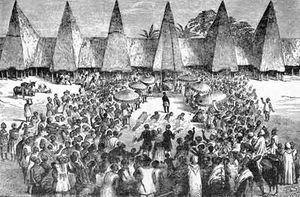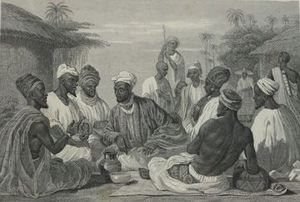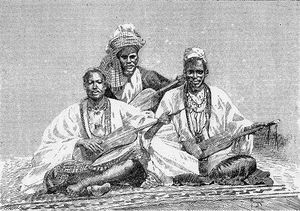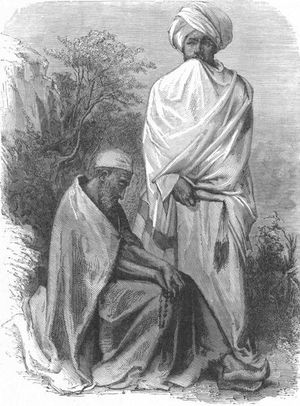Difference between revisions of "The Mengesha Tribe"
(→History) |
|||
| Line 7: | Line 7: | ||
|- style="vertical-align:middle;" | |- style="vertical-align:middle;" | ||
| style="height:100px" valign="top"| | | style="height:100px" valign="top"| | ||
| − | |||
|- style="color:blue; text-align:center; vertical-align:center;" | |- style="color:blue; text-align:center; vertical-align:center;" | ||
| ''<span style="font-size:x-small;"></span>'' | | ''<span style="font-size:x-small;"></span>'' | ||
Revision as of 21:18, 27 December 2018
|
The Mengesha Tribe is a southeron tribe traditionally inhabiting the deserts to the south of the Atlas continent. They have played a part in both the former Chieftaincy of Ghanyah and the current Rasdom of Melle.
Culture
The mengesha are traditionally sedentary agro-pastoralists, raising goats, sheep, and cattle in the desert, along with growing maize, millet, and Sorghum. Mengesha settlements range from small outlying villages to The capital city of Mennet. Mengeshan buildings are distinct for their architecture, characterized by two story square courtyard-based buildings, with thatched roofs, and family compounds with striking reliefs in brightly painted mudbrick.
Socially, the Mengesha are organized into clan families and have traditionally been a socially stratified society with a caste based social order. this consists of two classes of free strata; high-ranking clans(chiefs, warriors, priests), low-ranking clans(farmers herders, serfs), servile castes of artisans. (artists, craftsmen and griots etc.), and the slave class. The servile groups are socially required to be endogamous, while the slaves can be emancipated over four generations. In this way ones occupation is hereditary. There is a hierarchy of occupational clan status, with a clan specifically for the ruling Mesafin and clan associations specifically for elite soldiers ( called the “nobility of the spear”) Each clan has distinct privileges, rights, and leverage within society. Family and kin relatives are often involved in arranging weddings rather than either the bride or groom. A custom observed by the Mengesha, Kola nuts, a bitter nut from a tree, are formally sent by the suitor's family to the male elders of the bride-to-be, and if accepted, the courtship begins.
Mengeshan culture is rich in tradition, music and spiritual ritual. Mengeshans continue a long oral history tradition through stories, songs and proverbs. Because the Mengesha don't have a written language, oral history is passed down through griots. Griots are a caste of historians, storytellers, poets and/or musicians. The griot is a repository of oral tradition and is often seen as a societal leader due to their traditional position as an advisor to chiefs and nobles.This passing down of oral history through music has made music one of the most distinctive traits of the Mengesha. The hallmark instrument of the griots is the kora. The kora is a twenty-one-stringed guitar-like instrument made out of a halved, dried, hollowed-out gourd covered with cow or goat skin. The strings are made of fishing line (these are traditionally made from a cow's tendons). It is played to accompany a griot's singing or simply on its own.
The Mengesha do not worship multiple gods as in other lands. Most believe that the Ahkonnen is the only true god, though Mensaphi are sometimes mistaken by outsiders as deities. Mensaphi translates to spirits; immortal beings that act as the intermediaries between the mortal races and Ahkonnen, and have a variety of natures whether good, neutral or evil. Some mensaphi are rooted in ancestor worship; warriors, kings, and founders of villages are recognized as deities upon their deaths due to extraordinary feats. They are celebrated after death and join the pantheon of Mensaphi.The ancestors do not die, but are seen to have "disappeared" and become Mensaphi. Some of these mensaphis are based on historical figures confined to worship in their families or towns of origin; others are venerated across wider geographic areas. Other Mensaphi are more primordial beings of nature. Usually during the ritual of mourning after the death of a Mesafin or an person of great influence , artisans are commissioned to construct bronze heads of the deceased, as it is believed the soul resides within the “rasi” or head. The bronze head is meant to be recreated as accurately as possible, in the likeness of the deceased, so as the Mensaphi can find its rasi, and make it its home. The statue is usually then kept in the families home Ahkonnen at a shrine or temple to be worshiped and asked for guidance and help by the living. Ahkonnen itself is sometimes described as the disc of the sun, though it is spoken of as formless, beyond creation. More accurately described as the life-force that runs through all things, living and inanimate. It is described as the energy that make things happen. Akhonnen is worshiped through consultation or communion with the mensaphi,with the goal of achieving balance with them to receive favor. Practitioners traditionally believe that daily life depends on proper alignment and knowledge of one’s “rasi”, or head, but in spiritual terms, the soul.This is usually achieved through consultation with priests called "Debtera", who use their understanding of the spiritual world to contact or accrue favor with the mensaphi. They guide practitioners through the varying spirits important in their daily lives, usually, through libation, sacrifice (of animals, vegetables, cooked food, flowers, semi-precious stones, precious metals, etc.), fetishes and rituals. It is in this practice that the central theme of Mengeshan philosophy and belief is centered. belief in a cyclical nature of reality. The living stand between their ancestors and the unborn. Traditional belief embraces natural phenomena – ebb and tide, waxing and waning moon, rain and drought – and the rhythmic pattern of agriculture.
The traditional garment is the Shamma, worn by both men and women. The material used is cotton, calico or muslin and is usually white in color to show piety. A colored stripe over the right shoulder is used to indicate status. women wear the Shamma over a long white dress which often has a woven border. Men wear the Shamma over a long sleeved white tunic shirt, which is worn over long white trousers. charms, necklaces and jewelry are common, for religious purposes, aswell as symbols of wealth and status. Often due to the hot and dry climate men and women often wear a turban or a Fatalaa. It is a dyed cotton garment, with the appearance of both a veil and a turban. The Fatalaa covers the head. It prevents the inhalation of wind-borne sand by its wearers and gives protection from the dust and extremes of temperature characterizing dry environments. women in the Mengesha tribe, shave their heads bald or wear very close-cropped styles. The men are known for their stylish and conspicuous looking ‘asdago’ and ‘dayta’ buttered hairstyles. The ‘asdago’ afro hairstyles appear ashy as a result of butter being applied to them. The butter also protects the hair from the sun. The curls on the ‘dayta’ hairstyle, on the other hand, are created with sticks. The hairstyle is in reference to the long mane of lions, native to their lands, an animal revered as a symbol of divinity, specifically a symbol of Ahkonnen's presence. A man’s “mane” represents strength, protection, and masculine beauty.
Military
War and rebellion is at the center of Mengeshan history. The Mengesha are a warrior people and put a strong emphasis on martial ability. Boys are trained from early childhood in the use of the sword, spear and shield. Generally, soldiering has been the surest path to social advancement and economic reward within society. The Mesafin traditionally awards land, titles, and political appointments to those who prove their loyalty, competence, and courage on the battlefield. As a result, warriors traditionally give allegiance to the commander who could assure the fruits of victory to his followers. The elite of the Mengesha's fighting force are what is referred to as the the “Nobility of the spear”, a group of several warrior clans that form the elite core of the tribes military. They are nobles dedicated to serve the tribe through bearing the spear against the tribes enemies, serving as cavalry commanders. The head of each clan forms a council that advises the Mesafin in war. Though the elite of the Mengeshan warriors form the core,the entire tribe can be mobilized when a Mesafin orders a kitet, or call to arms. This is made by proclamations in the marketplaces and other gathering spots, and large war drums are beaten to alert outlying farms. Each man provides his own weapons and is expected to acquire skill in its use on his own initiative. If traveling far, He brings his own food for the march or forage en route. Often a soldier brings his wife or if he can afford it, a servant to cook and tend mules. The shotel is a favoured type of sword, a heavy steel weapon curved like a shamshir , but with the sharpened edge usually on the inside of the curve so that the warrior could stab around the edge of an opponent’s shield. It is carried slung on the right side, so that the left (shield) arm has a full range of movement. The Shotel is a symbol of prestige among warriors as it is a symbol of the sickles used by the valiant Tejju during the rebellion against the Zewa. Steel-headed spears are pretty much universal among men and boys for defending their flocks from wild animals; generally about 6ft long with a leaf-shaped head, they can be thrown, but are more often used for thrusting. Small shields complete a Mengeshan warrior’s kit. Styles vary among the tribe, but the most common is a circular, conical shield made of hide and covered on the front with coloured cloth such as velvet. Many are decorated and strengthened with strips of brass, tin or more valuable metals; a shield is an easy way for a warrior to show off his wealth and status, and many are quite elaborate.



